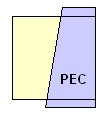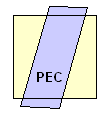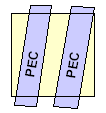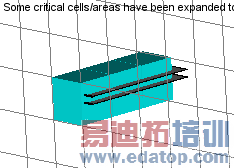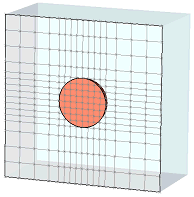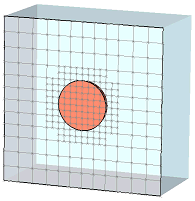- 易迪拓培训,专注于微波、射频、天线设计工程师的培养
CST2013: Advanced Mesh Strategies (Hexahedral)
In combination with the Finite Integration Method (FI-Method), CST MICROWAVE STUDIO offers some advanced mesh strategies to provide a flexible and detailed spatial discretization of the structure. Here, it is necessary to obtain a sufficient mesh resolution of the simulated model, especially for small or critical regions with the constraint to minimize the resulting total number of mesh points.
Perfect Boundary Approximation and Thin Sheet Technology
The Perfect Boundary Approximation (PBA) is used for the spatial discretization of the structure. The simulated structure and the electromagnetic fields are mapped to a hexagonal mesh. PBA allows a very good approximation of even curved surfaces within the cubic mesh cells. This works very well as long as the approximated structure is greater than the cell size of the mesh. For PEC structures where details are lower than the method’s resolution, the Thin Sheet Technology (TST) enables more than one non-PEC region within a single cell.
Both these techniques help to avoid extremely small mesh steps and thus positively influences the total simulation time.
|
|
|
|
A normal PBA mesh cell face with a single non PEC area. | TST allows to have two non-PEC areas. | A cell area with more than two non PEC areas (critical cell) must be filled completely with PEC material. | Mesh View of critical mesh cells that have been expanded with PEC. |
However, if there are more than two PEC areas in one cell, or if there is one single PEC area that is completely inside of a mesh cell face, the entire critical face or cell must be filled with PEC material. These critical areas / critical cells are then visualized in the mesh view.
PBA and mesh cell size
This works very well as long as the approximated structure is greater than the cell size of the mesh. Because, as in every discrete systems, the resolution of the method is limited by the sampling width. This means, that small details of the structure will be modeled accurately only if the mesh cell sizes are smaller than these details.
If TST is switched off, all critical cells/areas area expanded with PEC.
Multilevel Subgridding Scheme
The Multilevel Subgridding Scheme (MSS) ensures that a very dense mesh is only created within critical regions. The MSS can be globally activated or deactivated in the Special Mesh Properties - Advanced dialog by applying the Use subgridding option.
The subgrid mesh generation considers all global refinement settings (Special Mesh Properties - Advanced dialog) as well as most of the local settings defined for a specific solid (Local Mesh Properties dialog). In the picture below a volume refinement of a sphere is applied to a mesh with and without MSS. Thus, before pressing Update to generate the subgrids the preview mesh gives an impression of the quality of the refined regions.
|
|
Mesh without MSS | Mesh with MSS |
CST微波工作室培训课程套装,专家讲解,视频教学,帮助您快速学习掌握CST设计应用
上一篇:CST2013: Thermal Stationary Solver Overview
下一篇:CST2013: Curren Monitor Mode
 最全面、最专业的CST微波工作室视频培训课程,可以帮助您从零开始,全面系统学习CST的设计应用【More..】
最全面、最专业的CST微波工作室视频培训课程,可以帮助您从零开始,全面系统学习CST的设计应用【More..】
频道总排行
- CST2013: Mesh Problem Handling
- CST2013: Field Source Overview
- CST2013: Discrete Port Overview
- CST2013: Sources and Boundary C
- CST2013: Multipin Port Overview
- CST2013: Farfield Overview
- CST2013: Waveguide Port
- CST2013: Frequency Domain Solver
- CST2013: Import ODB++ Files
- CST2013: Settings for Floquet B

